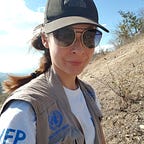A South-South collaboration takes flight: Madagascar and Mozambique launch advanced drone training
The sun was out for the first day of spring in the Southern hemisphere as the Advanced Unmanned Aircraft System (UAS) training, Let’s FLY, took to the warm skies above Antananarivo, Madagascar on 23 September.
The World Food Programme (WFP) practical training was the first inter-state, South-South collaboration of its kind, pairing facilitators and participants from governmental disaster management offices of Mozambique (INGC) and Madagascar (BNGRC).
Let’s FLY opened a bilateral exchange of best practices as government representatives from both nations presented strategies and ideas for the best way to use UAS technology in emergencies.
Over the ten-day exercise at Lake Mantasoa, participants clocked over 30 hours of flight time using 20 drones and 10 different systems, including fixed-wing and multi-rotor systems. They also became familiar with concepts around national airspace, flight preparation and safe operations as well as data collection and mapping.
Flying high to mitigate risk
Madagascar and Mozambique are a natural fit for a practical UAS training partnership as they are separated by 400 km of Indian Ocean and face similar natural disaster risks: cyclones, earthquakes and floods. Both countries also rank high in terms of socio-economic vulnerability.[1]
With support from the European Commission Humanitarian Aid and Civil Protection Directorate General (ECHO), WFP is committed to triangulating support for South-South collaboration across countries that have been identified as high-risk; the key objective of the recent UAS training was to assist BNGRC and INGC to effectively conduct preparedness operations and disaster management activities.
“The ECHO-funded programs in both Mozambique and Madagascar present a unique opportunity to leverage technology to save lives and change lives by increasing access to people in need, providing humanitarian coordinators with mission-critical information and detecting vulnerability before crisis while making operations more efficient and effective,” says Adam Marlatt, Global UAS Coordinator.
This South-South collaboration is a direct outcome of WFP-led UAS workshops in Mozambique (November 2017) and Madagascar (August 2018). In September 2018, both countries came together to train 25 participants from BNGRC, INGC and WFP Country Offices.
Fuelling up with data collection
The Emergency Telecommunications Cluster (ETC) — which is led globally by WFP — supports Madagascar’s ICT preparedness working group by providing UAS equipment to BNGRC for rapid response in future emergency deployments. The 18-month project will bolster baseline data collection in cyclone-prone areas of the eastern shoreline to aid the detection of damage, changes in infrastructure and soil erosion along the beachfront.
In Mozambique, WFP is performing the largest mapping operation using UAS ever conducted. It will cover 14,000 square kilometres across the Zambezi River Delta to point out informal settlements, create clear digital models that display mountains and identify hazard locations, which will in turn help pinpoint safer places to relocate people in the event of an emergency.
“Since we are establishing a UAS coordination cell for humanitarian assistance in Mozambique, this training gave our representatives the confidence in operating various drones INGC is planning to purchase which will be used for emergency preparedness and response,” says Antonio Beleza, Information Management Officer with National Emergency Operation Centre (CENOE) at INGC. “Through this collaboration with Madagascar we will be able to leverage each other’s expertise and assist one another when the next disaster hits.”
Despite language barriers and fatigue after ten intense training days — which included a 24-hour emergency simulation, complete with a night-time search and rescue demonstration — Madagascar and Mozambique representatives built a solid team. A strong South-South collaboration, empowered by cutting edge UAS training, is ready for take-off when the next natural disaster comes to pass.
